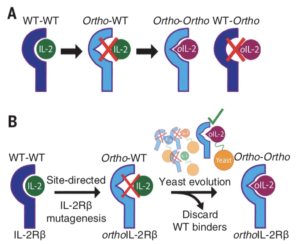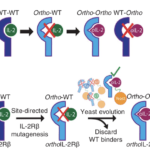
Sockolosky et al., 2018. Figure 1 A-B: Engineering and characterisation of orthogonal IL-2 and IL-2R pairs. (A) Schematic overview of orthogonal IL-2/IL-2R pairs, consisting of a mutant IL-2 cytokine and mutant IL-2R
that interact specifically with each other but do not cross-react with their wild-type counterparts. (B) Strategy used to engineer orthogonal IL-2/IL-2Rb pairs.
Recombinant human interleukin-2 (rhIL-2) is used as an adjunct therapeutic for treatment of selective types of cancer. rhIL-2 is an essential T cell growth factor that improves survival, function and anti-tumour activity of adoptively transferred tumour-reactive T cells during cancer immunotherapy. Treatment with rhIL-2 does have challenges as it can induce endogenous immune cells such as regulatory T cells (T-regs) that may inhibit anti-tumour activity, as well cause severe toxicity. Thus, successful use of rhIl-2 during adoptive T cell transfer requires a balance between activation of transplanted T cells and endogenous cells that have natural IL-2 receptors (IL-2R).
Researchers hypothesise that developing a mutant IL-2 cytokine and IL-2R pair with specificities for one another and not the wild-type IL-2 and IL-2R could alleviate toxicity and non-specific immune activation/repression induced during rhIL-2 treatment. Sockolosky et al., developed two pairs of orthogonal murine IL-2 /IL-2Rβ mutant pairs using mutagenesis. Researchers chose the β subunit of IL-2 because it is required for IL-2 signal induction and can independently bind to IL-2.
Using in vitro experiments researchers showed that the selected ortho-IL-2 and ortho-IL-2R bound with similar affinity as wild-type IL-2 and IL-2R. Despite addition of mutations in ortho-IL-2 that were meant to abrogate binding to wild-type IL-2R, Sockolosky et al., demonstrated that ortho-IL-2 1G12 was able to bind to wild-type IL-2R resulting in STAT5 phosphorylation of STAT-5, T cell growth and increased toxicity in vivo. Researchers successfully demonstrated that ortho-IL-2 3A10 retained its specificity for ortho-IL-2R and did not bind to wild-type IL-2R limiting none-T cell immune responses and toxicity. Finally, researchers demonstrated that both ortho-IL-2 molecules were able to expand T cells and promote anti-tumour responses limiting tumour growth in an in vivo mouse model of melanoma.
This research highlights the potential of bioengineering current therapeutics to improve activity and limit toxicities. A potential limitation of using a recombinant ortho-IL-2/IL-2R is abrogation Il-2 induced anti-tumour activity in endogenous cells such as natural killer cells.
Journal Article: Sockolosky et al., 2018. Selective targeting of engineered T cells using orthogonal IL-2 cytokine-receptor complexes. Science
Article by Cheleka AM Mpande
